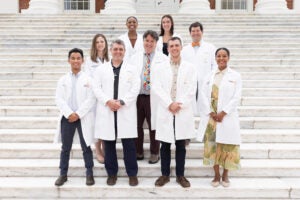Vascular Neurology Fellowship
Since 1984, the University of Virginia Stroke Center has taken a leadership role in clinical stroke research including the initial NIH-funded pilot studies of alteplase (tPA). UVA has pioneered the development and implementation of acute stroke intervention teams, reliable clinical & imaging endpoints for studies of patients with subarachnoid hemorrhage, futility analyses for acute stroke studies, and clinical prediction models for use in clinical trials. UVA continues to lead methodological innovation such as the sequential elimination design developed for the advanced phase 2 randomized, controlled, multi-center trial of tenecteplase (TNK) in acute ischemic stroke. Additional areas of academic/ research focus include health disparities, translational research including multi-omics, machine learning/artificial intelligences, mobile health, and patient safety & quality.
Fellowship Structure
We have 2 Fellows in our program per academic year.
Year 1: ACGME year is devoted entirely to clinical research and clinical management of stroke patients. Rotations include neuroradiology, neurocritical care, neurorehabilitation, and noninvasive neurovascular laboratory. Active telemedicine/ telestroke program gives fellows exposure and an opportunity to actively participate to this growing mode of stroke care delivery.
Year 2: Strongly recommended for those interested in academic career. The second year is flexible with opportunities for training in clinical trials methodology, for bench research in the pathophysiology and treatment of cerebral ischemia, or for translational research in cerebrovascular atherosclerosis. Formal training in clinical research design and statistics available with option to pursue M.Sc. degree (Department of Public Health Sciences). Also option to pursue advanced training in medical education or patient safety and quality.
Stroke call is shared among the junior and senior stroke fellows, the stroke and critical care attendings, and the critical care fellows. Acute Stroke call two nights per week during Year 1 and one night per week in year 2 (no weekend call).
We participate in the NRMP Match.
Please apply through the ERAS system.
For more information contact Katie Christie at University of Virginia Health System
Box 800394
Charlottesville, VA 22908
(434) 243-1552 MWG3UW@uvahealth.org
Applicants must be eligible for a full Virginia medical license and a DEA number
Additional Information about UVA Hospital
The University of Virginia Hospital is a 645-bed tertiary referral and regional primary care hospital with approximately 25,000 admissions each year. The inpatient stroke unit admits over 700 patients each year. There are over 1000 cerebrovascular admissions each year. The Nerancy Neurological Intensive Care Unit has approximately 1100 admissions each year.
- Joint Commission certified Comprehensive Stroke Center
- Joint Commission certified Rehabilitation Stroke Center
- Faculty include 6 fulltime and 2 part-time Board Certified Vascular Neurologists, stroke trained Neurohospitalist, and neurology trained nurse practitioner
- 12 bed Stroke Unit
- 12 bed Neurocritical Care Unit staffed by Neurointensivists
- 12 bed Neuro Intermediate Care Unit
- Close interaction with interventional neuroradiology & vascular neurosurgery including weekly multidisciplinary clinical conference
- A team of 5 fulltime clinical research coordinators
- Active clinical and research telemedicine project
- One of 25 NIH/NINDS funded StrokeNet Regional Coordinating Center (RCC)
- Active acute treatment and prevention research protocols including collaborative multi-disciplinary efforts with other neurology divisions, neurosurgery, cardiology, vascular surgery, and interventional neuroradiology
- NIH/NCATS funded Clinical Translational Science Network Program – The integrated Translational Research Institute of Virginia (iTHRIV) with Virginia Tech/Carilion Clinic/ Inova
Life in Charlottesville

Founded by Thomas Jefferson in 1819, the University sustains the ideal of developing, through education, leaders wh o are well-prepared to help shape the future of the nation. Cu rrent enrollment tops 20 thousand in all schools. UVA continues to rank in the Top 25 of all national universities, public and private by U.S. News.
Charlottesville is a small, thriving city with a population of 45,000; the local area population is 145,000. Charlottesville is two hours from Washington, DC. There are few places in the United States that combine a picturesque and cultivated countryside that is so rich in historical associations with the proximity of a national park and a wide array of cultural opportunities. As a college town, Charlottesville is full of arts, culture, and shopping venues. Charlottesville is the home of the Virginia Film Festival, the Virginia Festival of the Book, and Look3: The Festival of the Photograph. The entrances to the Shenandoah National Park and the Blue Ridge Parkway are 20 minutes from the University and are a gateway to a vast network of trails and other activities. Outdoor enthusiasts will love the local rivers and lakes, where they can sail, kayak, canoe, and fish. Charlottesville is home to Thomas Jefferson’s home, Monticello, and the college he designed, the University of Virginia.

